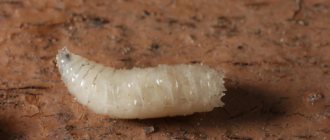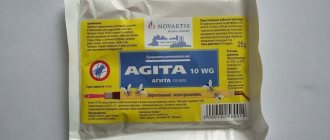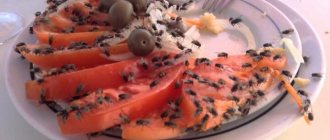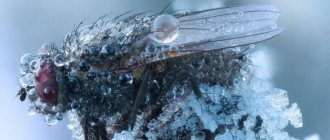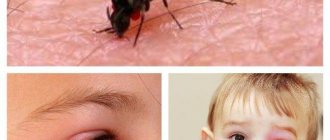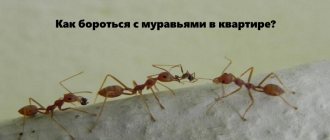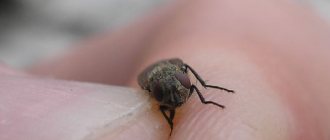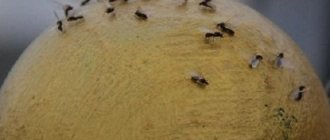Food forgotten on the table can attract flying guests who are out of place in the kitchen. We are talking about insects called fruit flies. Another name is fruit fly. Their appearance indicates that fruits or vegetables left for storage have begun to deteriorate within the home. It’s worth figuring out where these flies come from and how to remove unpleasant neighbors from your living space.
Description of the insect
The small Drosophila fly is a two-winged creature not exceeding 2.5 mm in length. It lives on all continents, with the exception of the coldest regions. Despite the fact that during the flight the insect appears black, up close it has a very interesting color scheme: the eyes are bright red, and the body has a yellow-brown tint. Dark transverse stripes are observed on the abdomen.
The insect does not bite and does not carry dangerous diseases . They don’t care about clothes and interior items, but plant foods and rotting remains attract them very much. Sometimes the fruit fly Drosophila can be called wine fly or vinegar fly because of its predilection for fermented products. You will not find such a creature in one copy; they always fly in flocks.
The lifespan of an insect depends on temperature. If it is about 25 C, then the fly lives for ten days. When the temperature drops to 18 C, the period doubles.
During its entire habitat cycle, Drosophila is capable of laying approximately four hundred larvae. Under suitable conditions, a sexually mature individual will have offspring within a day. For five days it feeds on microorganisms or fruit juice. Then the larvae become pupae and develop for the same amount of time. The young specimen that appears ten days later becomes sexually mature within two days.
Do fruit flies bite?
Fruit flies and their lifestyle pose a very real health threat, but do fruit flies bite?
The diet of fruit flies includes:
- Fruits
- Vegetables
- Young leaves and shoots
- Salad and greens
- Plant juice
- Honeydew
- Organic waste in drains
The jaws of fruit flies are adapted to absorb plant and liquid food of a soft consistency.
Fruit flies are physically unable to bite through skin and drink blood, so they do not bite. If you still notice bites on your body, it means they were left by someone else. Of the species close to flies, these can be either carnivorous midges or burner flies. The latter are most active in autumn, have a light body covered with dark spots and lines, feed on blood and are carriers of a number of dangerous diseases transmitted through bites.
The skin reaction to different insect bites can look almost identical. This greatly complicates the identification of the pests that left them, however, in some cases, the damage still has some characteristic features inherent in specific species. Therefore, before you decide that it is flies that are attacking you, find out what bites look like
the most common domestic insects. Perhaps they were left by parasites that have nothing to do with flying pests at all.
How does it get into the home?
In the warm season, the likelihood of encountering uninvited guests increases. Storing grown food indoors and favorable conditions around it allow insects to reproduce at high speed. But they can be “bred” into housing in winter, if the right environment is created. The main factors for the appearance of fruit flies are warmth and food.
They get into the apartment:
- along with vegetables and fruits brought from the store;
- with garden crops grown on your site;
- from non-disinfected soil added under indoor flowers;
- through open windows and doors;
- Animals can also “transport” fruit flies on their fur.
Fly larvae are very small, you cannot see them on fruit, much less on your pet. Even a pair of winged specimens that accidentally flew into a window, under the right conditions, will be able to lay large offspring.
Modern methods of struggle. Market news
Serious means of killing fruit flies are chemical aerosols and insecticides. They act instantly but are toxic to people and pets. The optimal solution is the use of a modern, strong and completely safe product - Natural aerosol against FLYING AND Crawling insects.
BONA FORTE brand aerosol is a new development of the company, created for the instant destruction of insect pests such as fruit flies, whiteflies, aphids and spider mites.
The aerosol protects indoor plants and outdoor ornamental plants from pests. The product instantly neutralizes insects without causing resistance. It is safe because... decomposes quickly.
Another advantage of Aerosol is its economical consumption.
Reasons for the rapid spread
Sometimes a person himself creates a suitable environment for the reproduction of such insects, and then he is surprised at where fruit flies come from. An insect infestation occurs if the following factors are found in a residential area:
- stale dirty dishes;
- a trash can forgotten for a long time;
- bottles of sweet soda, juice or wine left for storage;
- fruits and vegetables that are kept warm;
- old tea leaves in a teapot or watering a flower on a window.
Flies and their larvae feed on decomposed food scraps. Any rotting organic matter in the house is a potential “nest” in which a mass of flying midges can appear. In order not to encounter this in your home, you must adhere to hygienic standards in everything related to food.
Getting rid of midges
Drosophila are not the kind of insects that, when you see them, you need to run to a specialized store for poison. Anyone can cope with them. Basically, you just need to reconsider your habits and make a little effort to create cleanliness in the house.
The extermination of midges must begin with several actions:
- If no external sources of rotting have been identified in the house (the trash can is clean, there are no spoiled foods on the table), it is worth conducting an audit of the supplies located in parts of the apartment hidden from view. These are balconies, storage rooms, under-bed space and other places suitable for storing non-perishable foods.
- Then you need to eliminate everything that has gone bad. Good foods should be put in the refrigerator. Without food, fruit flies cannot survive.
- If possible, you need to catch insects. They fly quite quickly, but people usually use “folk” methods of swatting flies: newspaper or towel. You can also make a homemade fruit fly trap.
It is recommended to poison midges with dichlorvos and similar means only if there are a lot of them and cannot be dealt with manually.
In this case, it is necessary to leave the room after treatment, otherwise harm will be caused to the body. And also when using pesticides, you need to take care of your eyes and other mucous membranes, and wash your hands.
Swelling of the eyes due to a midge bite
Midges are one of the smallest blood-sucking insects that are so common in our latitudes. In addition to the fact that they bite people on exposed parts of the body, they can also get under clothes, into the ears, nose and of course into the eye.
A midge bite to the eye can be especially dangerous. In addition to swelling, itching and an allergic reaction, excessive lacrimation may occur.
In addition to all the risks listed, there is an added risk of vision deterioration and even complete loss.
First aid for a bite to the eye, or eye area, is almost the same as for a regular bite.
- First of all, you need to rinse your eye with plenty of cold water.
- Take or smear the eyelid, if possible, with an antihistamine.
- Cold compresses (ice cubes or any other cool objects) help relieve swelling.
- You can use a compress of grated potatoes, or apply a potato slice directly.
- For further consultation, it is recommended to contact an ophthalmologist to prescribe special medications.
You should not use alcohol-containing substances, as well as hydrogen peroxide, as there is a possibility of damaging the mucous membrane of the eye.
Traps from improvised means
Simple devices that will attract fruit flies and prevent them from flying away can be made in 10-20 minutes. Almost everyone has everything needed for this at home. The most popular traps are:
- Glass jar. You need to take a small version of this dish, up to 1 liter (even a glass will do). Pour some juice, wine, beer, liquid jam inside, or place pieces of sour tomato or stale apple. Stretch cling film over the neck and tie it. Use a toothpick to make several holes on top so that the flies can find the entrance to the alluring treat and install it where they accumulate the most.
- Plastic bag. The easiest way to catch fruit flies. Leftover food is also placed in it, and when the main swarm flocks to them, the bag must be quickly closed and tied. If some flew out or simply did not have time to get there, we repeat the procedure. The package and its contents should be immediately taken away from the home. Polyethylene breaks easily and you can lose the collected “treasure”.
- A disposable plastic cup or similar container that you won’t mind throwing away. You need to roll a small cone out of paper and glue it along the seam. Then cut a little paper from the sharp end to make a small hole and insert this structure into the glass with the narrow part down. It is advisable to seal the edges of the container so that insects do not crawl out. The glass also needs to be filled with attracting residues first. If they are in the form of a liquid, you need to make sure that the paper cone does not reach it.
There can be different variations of such traps; it’s easy to come up with them yourself. The main thing is that the “food” is suitable.
Ecology and scientific benefits
Flies of this species are found throughout the world, but most often in tropical regions. They can be found in deserts, tropical forests, cities, swamps and alpine regions. Some northern species of flies are capable of overwintering. Most reproduce in various plant species and decaying fungal masses, including:
- fruits;
- bark;
- flowers;
- macroscopic mushrooms.
Larvae of at least one species, D. suzukii, can feed on fresh fruit and are classified as pests. Several species of individuals live according to the parasitic and predatory type of life. Others, including melanogasters, are closely related to humans and are often referred to as domesticated insects, such as the fruit flies found in kitchens.
Drosophila are a popular experimental material in genetic research because they are easy to grow in the laboratory and have a very short lifespan. Those. Generations change quickly, and it is convenient to observe mutations. In short, these insects can produce such evolutionary changes within a few years that would require millions in nature.
In 1906, Thomas Hunt Morgan first appreciated the possibilities of fruit flies and began his work on melanogasters. Already in 1910, he managed to breed flies with white eyes. His research earned him the 1933 Nobel Prize in Medicine. His work was based on the study of the identification of chromosomes as carriers of gene inheritance. Since then, Melanogaster and other Drosophila species have been widely used in studies of genetics, embryogenesis and other areas of natural science.
Additional methods
If there were few insects or there was no desire to make something, you can drive out fruit flies with the help of pungent odors. Essential oils and other aromatic agents will help “smoke” them. Midges cannot tolerate :
- pine needles, lavender, citrus fruits (oil should be used in an aroma lamp);
- the smell of heated camphor;
- incense;
- the aroma of dried herbs like wormwood, tansy or lavender.
If you have dried bouquets of similar plants on your farm, you should lay them out or hang them up.
Preventive measures
To avoid sharing your food with annoying flies, you need to follow simple rules for storing food and caring for your home. Hygienic actions will get rid of not only fruit flies, but also ordinary flies, ants and even cockroaches:
- You need to throw out garbage regularly. It is better to have a small container for this that will fill quickly.
- Store vegetables and fruits in a cool place, preferably in the refrigerator, using the freshness zone (if available). It happens that the volume of plant products is large and it is impossible to place them in the unit. Then you need to sort through the fruits more often to identify spoiled specimens.
- To prevent fruit flies from entering the house from the street, it is necessary to install nets and similar devices on the windows.
- If you want to store containers of juice, wine and other sweet drinks, you must first wash them with soapy water.
- Wipe up spilled puddles of any liquids on the floor and furniture.
- Wipe off crumbs from the table and do not store spoiled food on it.
- The dishes need to be washed in time before the flies find their “delicacy” in it.
It is always easier to prevent the appearance of unwanted insects than to fight them later. Drosophila are harmless creatures, although living next to them is not very pleasant. In any case, fighting midges will not be difficult. The main thing is to remember the hygiene of your home.
How do you like the article?
How long does a midge bite take to heal?
How long the swelling from a bite lasts depends on your health condition. On average this is:
- For mild skin reactions – from 1 to 4 days.
- For local allergies – from 4 days to 1.5 weeks.
- For an initially severe allergic reaction – from 1 to 2 weeks.
In addition to allergies, the duration of the presence of edema can also be affected by the location where it is located and the rate of metabolic processes in the body. With proper treatment and supportive care, intense swelling in most cases is relieved within 1–3 days; further recovery gradually eliminates the remaining symptoms within 10–14 days. How long the bite lasts and how long it takes for it to heal completely so that not a trace remains of it depends on the speed of skin cell regeneration, which is also highly individual and can take from a week to 1 month or more.
